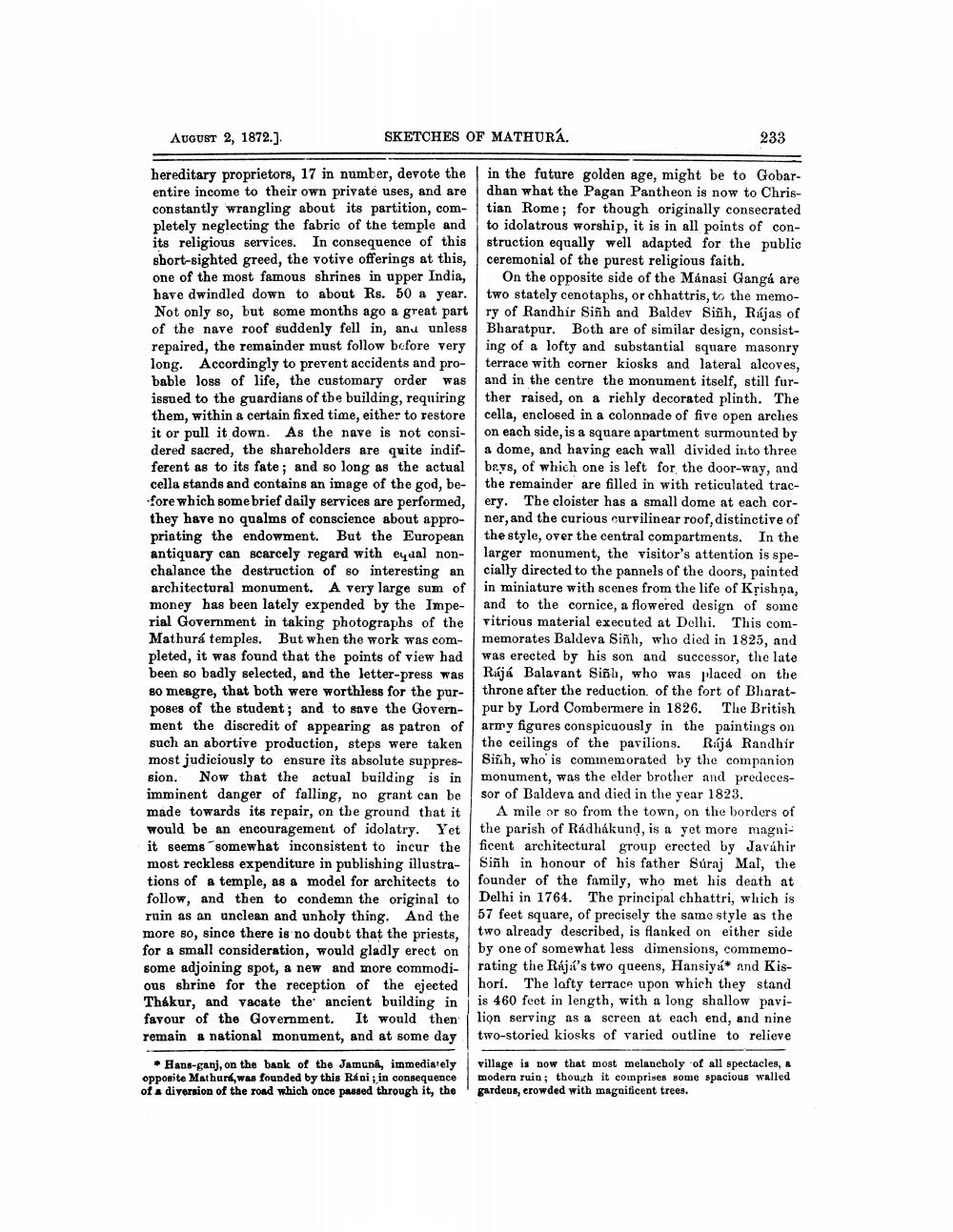________________
SKETCHES OF MATHURA.
AUGUST 2, 1872.].
hereditary proprietors, 17 in number, devote the entire income to their own private uses, and are constantly wrangling about its partition, completely neglecting the fabric of the temple and its religious services. In consequence of this short-sighted greed, the votive offerings at this, one of the most famous shrines in upper India, have dwindled down to about Rs. 50 a year. Not only so, but some months ago a great part of the nave roof suddenly fell in, and unless repaired, the remainder must follow before very long. Accordingly to prevent accidents and probable loss of life, the customary order was issued to the guardians of the building, requiring them, within a certain fixed time, either to restore it or pull it down. As the nave is not considered sacred, the shareholders are quite indifferent as to its fate; and so long as the actual cella stands and contains an image of the god, before which some brief daily services are performed, they have no qualms of conscience about appropriating the endowment. But the European antiquary can scarcely regard with equal nonchalance the destruction of so interesting an architectural monument. A very large sum of money has been lately expended by the Imperial Government in taking photographs of the Mathurá temples. But when the work was completed, it was found that the points of view had been so badly selected, and the letter-press was so meagre, that both were worthless for the purposes of the student; and to save the Government the discredit of appearing as patron of such an abortive production, steps were taken most judiciously to ensure its absolute suppression. Now that the actual building is in imminent danger of falling, no grant can be made towards its repair, on the ground that it would be an encouragement of idolatry. Yet it seems somewhat inconsistent to incur the most reckless expenditure in publishing illustrations of a temple, as a model for architects to follow, and then to condemn the original to ruin as an unclean and unholy thing. And the more so, since there is no doubt that the priests, for a small consideration, would gladly erect on some adjoining spot, a new and more commodious shrine for the reception of the ejected Thakur, and vacate the ancient building in favour of the Government. It would then remain a national monument, and at some day
Hans-ganj, on the bank of the Jamuna, immediately opposite Mathura,was founded by this Ráni ; in consequence of a diversion of the road which once passed through it, the
233
in the future golden age, might be to Gobardhan what the Pagan Pantheon is now to Christian Rome; for though originally consecrated to idolatrous worship, it is in all points of construction equally well adapted for the public ceremonial of the purest religious faith.
On the opposite side of the Mánasi Gangá are two stately cenotaphs, or chhattris, to the memory of Randhir Siñh and Baldev Siñh, Rájas of Bharatpur. Both are of similar design, consisting of a lofty and substantial square masonry terrace with corner kiosks and lateral alcoves, and in the centre the monument itself, still further raised, on a richly decorated plinth. The cella, enclosed in a colonnade of five open arches on each side, is a square apartment surmounted by a dome, and having each wall divided into three bays, of which one is left for the door-way, and the remainder are filled in with reticulated tracery. The cloister has a small dome at each corner, and the curious curvilinear roof, distinctive of the style, over the central compartments. In the larger monument, the visitor's attention is specially directed to the pannels of the doors, painted in miniature with scenes from the life of Krishna, and to the cornice, a flowered design of some vitrious material executed at Delhi. This commemorates Baldeva Siñh, who died in 1825, and was erected by his son and successor, the late Rájá Balavant Sinh, who was placed on the throne after the reduction of the fort of Bharatpur by Lord Combermere in 1826. The British army figures conspicuously in the paintings on the ceilings of the pavilions. Rájá Randhir Siñih, who is commemorated by the companion monument, was the elder brother and predecessor of Baldeva and died in the year 1823.
A mile or so from the town, on the borders of the parish of Rádhákund, is a yet more magnificent architectural group erected by Javáhir Siñh in honour of his father Suraj Mal, the founder of the family, who met his death at Delhi in 1764. The principal chhattri, which is 57 feet square, of precisely the same style as the two already described, is flanked on either side by one of somewhat less dimensions, commemorating the Rájá's two queens, Hansiya and Kishorí. The lofty terrace upon which they stand is 460 feet in length, with a long shallow pavilion serving as a screen at each end, and nine two-storied kiosks of varied outline to relieve
village is now that most melancholy of all spectacles, a modern ruin; though it comprises some spacious walled gardens, crowded with magnificent trees.




